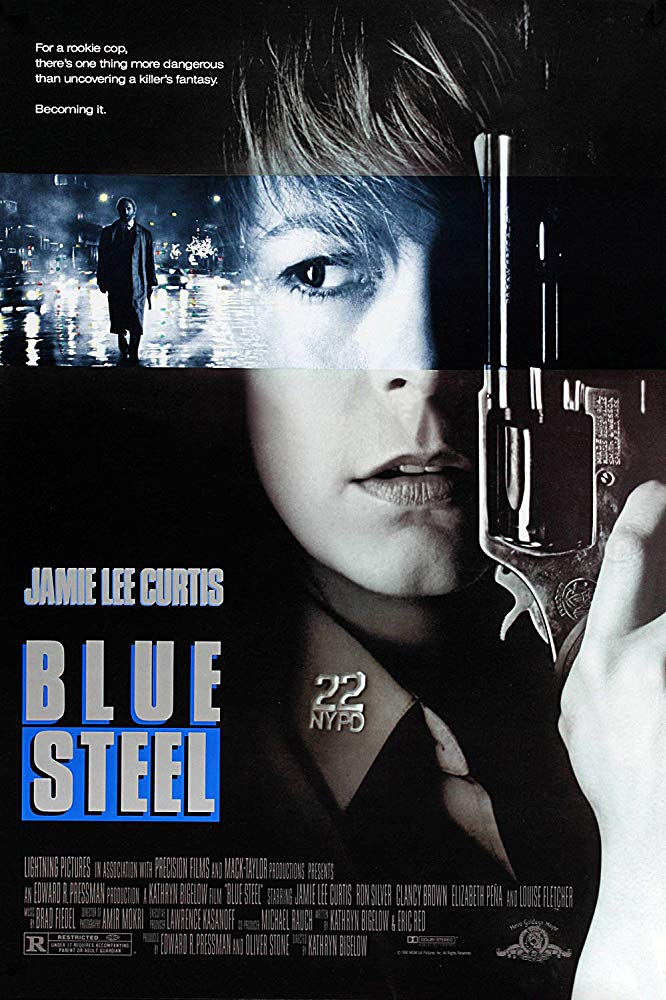BLUE STEEL Reconfigures the Werewolf Myth to Reflect the Modern Fears of Women
In recent years, there has been a growing cultural awareness of the extent to which the film industry is by and large dominated by men both in front of and behind the camera. To put a spotlight on women working in film, I am participating in the 52 Films By Women challenge. The requirements: watch at least one (1) new-to-you film per week that has been directed by a woman. As I make my way through the year, I will be reviewing each film I see as part of the challenge here.
52 Films By Women Entry #: 6
Rookie NYPD cop Megan Turner (Jamie Lee Curtis) is having a rough week on the job. Having just graduated from the Police Academy, she spies a gunman terrorizing a grocery store while on patrol. She immediately rushes into the store, sending the perp through a plate-glass window when she guns him down. Her swift action earns her a suspension. Then, a string of senseless killings begins in Manhattan, carried out using the gun belonging to the man she killed. The real kicker comes with the realization that the man she’s started seeing (Ron Silver) could be the killer.
The seeming challenge Kathryn Bigelow posed to herself in directing Blue Steel was to make a monster movie without a literal monster, and she succeeds handily. Following up her breakout success in the cult vampire western Near Dark, she evokes the supernatural without rendering the details explicit. The great monsters of horror have always served as metaphor in fiction, Bigelow herself using the vampire to explore the rules of a society in micro and the allure of rebellion.
Here she transposes the werewolf myth onto a nuts-and-bolts cop thriller. The film is not subtle about it's abstract connection, fully revealing the slick Wall Street broker Eugene's psychopathic nature under the light of a full moon, howling as he scratches bloody streaks into his own flesh. The wolf man has frequently represented the fear of one’s own suppressed id, of an instinctual, untapped capacity for violence. The wolf of Blue Steel, however, has no such fear. Eugene relishes the opportunity to indulge his bloodlust, eagerly waiting for the means to do so. Even if he hadn’t been at that grocery store on that fateful night - and not been in a place to swipe that gun - the psychotic glisten would’ve still been in his eye; he would’ve found another way to kill.
The core of the drama and fear instead comes from Megan’s perspective. What if someone close to me turns out to be a monster? What if they try to hurt me? What would happen if I told someone about it? Would I be believed? These fears would be familiar to most women in a world of rampant abuse at the hands of men, and casual observers willing to dismiss their complaints as hysteria. Blue Steel’s world is infected by bias against women, and Megan is not immune. Her shootout in the grocery store recalls any number of beats from contemporary, male-fronted action films that would be portrayed as heroic, and received the same way according to the film’s own internal logic. But Megan is punished for it, her actions and decisions put under the highest scrutiny and most rigorous questioning. Once Eugene reveals his murderous nature to her, the film becomes a long parade of gaslighting, with her own colleagues siding with him in her story.
Director:
Kathryn Bigelow
Starring:
Jamie Lee Curtis
Ron Silver
Clancy Brown
Screenplay by
Kathryn Bigelow &
Eric Red
Megan herself underestimates the capabilities of a woman in the film’s opening. Megan clears a building in a mock hostage situation, barging into the room where a man is holding his wife at gunpoint. She shoots the man, turning her back on the woman, who picks up the dropped gun and shoots her. The assumption that women could not be violent turns on her, hindering her ability to accurately assess risk. The scene effectively sets up the cage of standards Megan will have to navigate over the course of the film. Women are just as capable of using force as men, but will be punished more harshly for doing so, and if they choose not to use it, they won’t be believed about the things that happen to them because of that decision. In a twisted bit of egalitarianism, it is the capacity to kill that Eugene recognizes in her at the grocery store that attracts him to her, a reflection of how abusers can project their own morality onto others as a means to excuse themselves for their actions.
Bigelow isn’t necessarily about big statements here, even if you can feel the rawness of the anger felt at the film’s various injustices. On the whole she directs the film as a straight-ahead thriller with a simple, no nonsense premise, shot through with the cold, metallic visual style and explosive action she was known for in her early career. The dressings of the narrative are what bring the subtext to the fore. Jamie Lee Curtis’ long history as a slasher movie heroine in particular calibrates the audience’s perception of Megan as a character, positioning her as an inevitable victim. But just as inevitable in the film is her own righteous fury and self-defense. Eventually, someone has to take care of the bad guy, and if no one else is gonna do it, the women will just have to do it themselves.
Blue Steel is available on DVD, and can be rented on most digital video platforms

